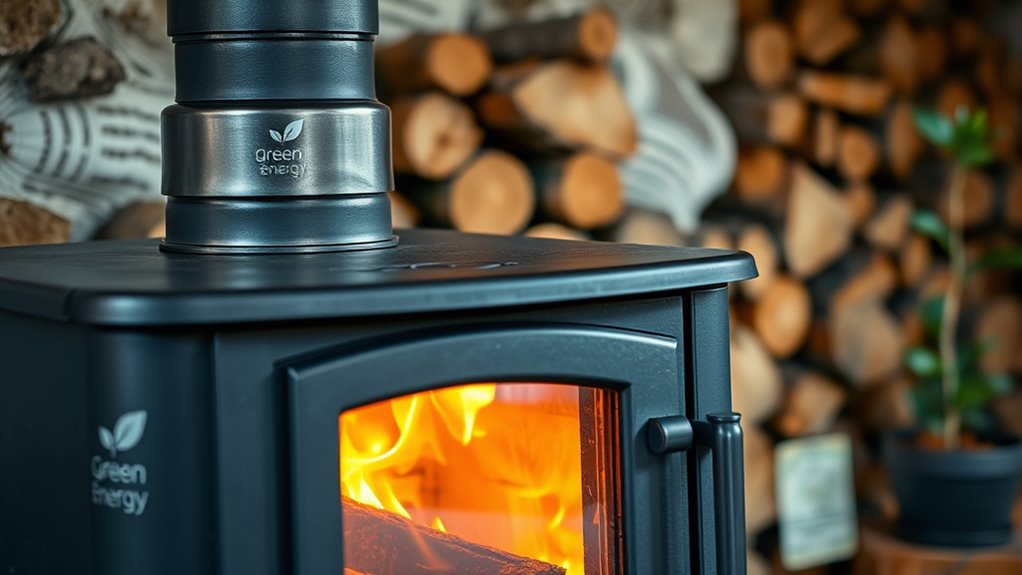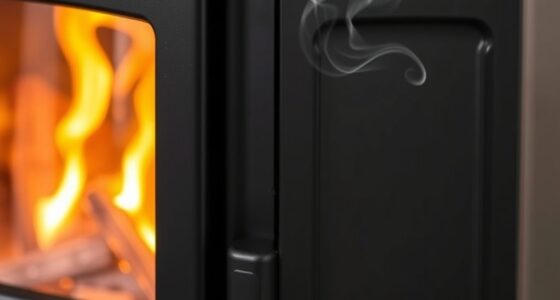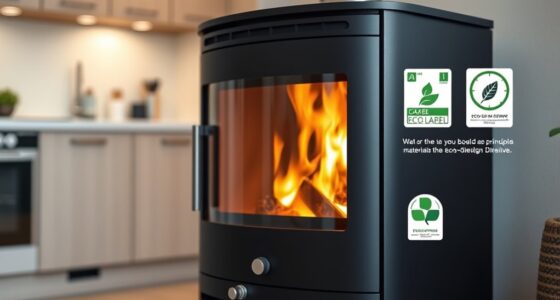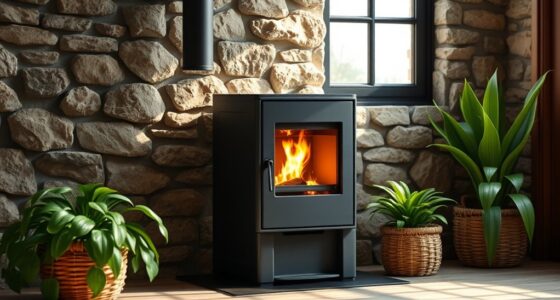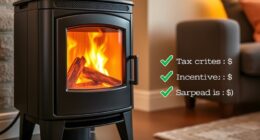To cut emissions from your wood stove, operate it properly by burning at its nominal load with a blue-tinted flame and regular airflow adjustments. Use dry, seasoned wood with less than 20% moisture and avoid overloading. Regularly clean your chimney and inspect components for soot buildup. Upgrading to a modern, certified stove with automated controls can markedly reduce pollutants. Keep practicing these tips, and you’ll discover simple ways to make your stove cleaner and more efficient.
Key Takeaways
- Burn at nominal load with a blue-tinted flame for efficient, cleaner combustion.
- Use dry, seasoned wood below 20% moisture to minimize smoke and emissions.
- Regularly clean chimneys and inspect stove components to prevent soot buildup.
- Upgrade to certified, modern stoves with advanced air controls for lower emissions.
- Maintain proper airflow and operate the stove consistently at optimal temperatures.
Proper Stove Operation for Minimal Emissions
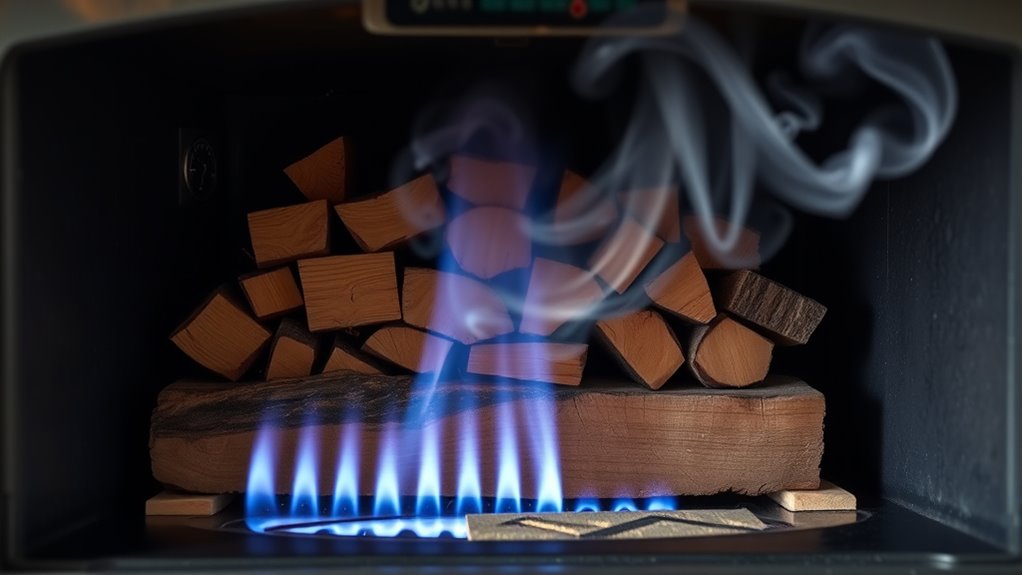
To minimize emissions from your wood stove, it’s essential to operate it properly. Burning at its nominal load helps reduce pollutants and improves combustion efficiency. Burning with a proper air-to-fuel ratio allows for cleaner and more complete combustion, reducing smoke and creosote buildup. You want a light-colored, blue-tinted flame near the wood, indicating proper air regulation and complete combustion. Proper fire management includes lighting from the top of the fire, which promotes cleaner burning and better airflow. Avoid choking the fire by restricting airflow too much; instead, adjust the air supply gradually to maintain stable combustion. Adding small amounts of wood frequently helps sustain high temperatures and prevents excess smoke. Maintaining good airflow and flame color ensures clean burning, reduces emissions, and keeps your wood stove running efficiently. Regular stove maintenance is also vital for optimal performance and emission reduction. Proper operation is key to enjoying warmth while protecting the environment. Being aware of airflow management can further enhance combustion and minimize emissions. For example, understanding how to optimize your stove’s combustion efficiency can lead to even cleaner and more effective burning.
Techniques to Maximize Combustion Efficiency
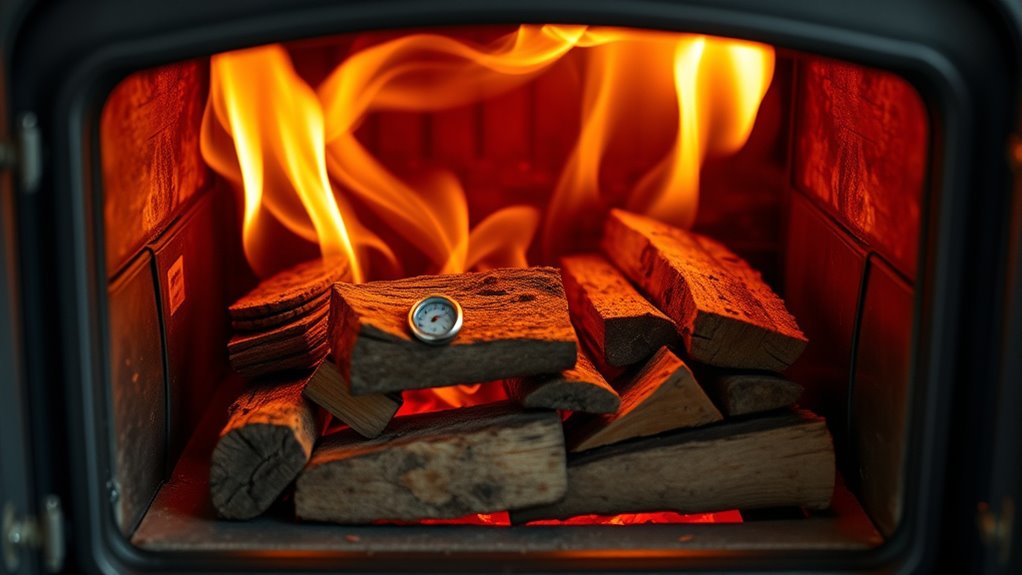
Maximizing combustion efficiency requires careful attention to your wood stove’s operation and the quality of your fuel. To enhance emission reduction, start with dry, seasoned wood that has a moisture content below 20%, ensuring complete combustion and fewer particulates. Firing your stove at its nominal load maintains ideal temperatures, reducing unburned emissions by up to 80%. Use proper air regulation to keep flames light-colored and blue near the wood, which promotes stable flames and lowers particulate emissions. Additionally, consistent stove maintenance—like chimney sweeping and inspections—prevents soot buildup that hampers efficiency. Remember these key techniques:
Optimize your stove by using seasoned wood, maintaining proper air flow, and operating at ideal temperatures for cleaner, more efficient burning.
- Use dry, seasoned wood with low moisture content.
- Maintain proper air regulation for complete combustion.
- Operate at the stove’s nominal load for ideal temperatures.
- Regularly check and monitor wood fuel quality to ensure optimal combustion and emission reduction.
Benefits of Upgrading to Modern, Certified Stoves
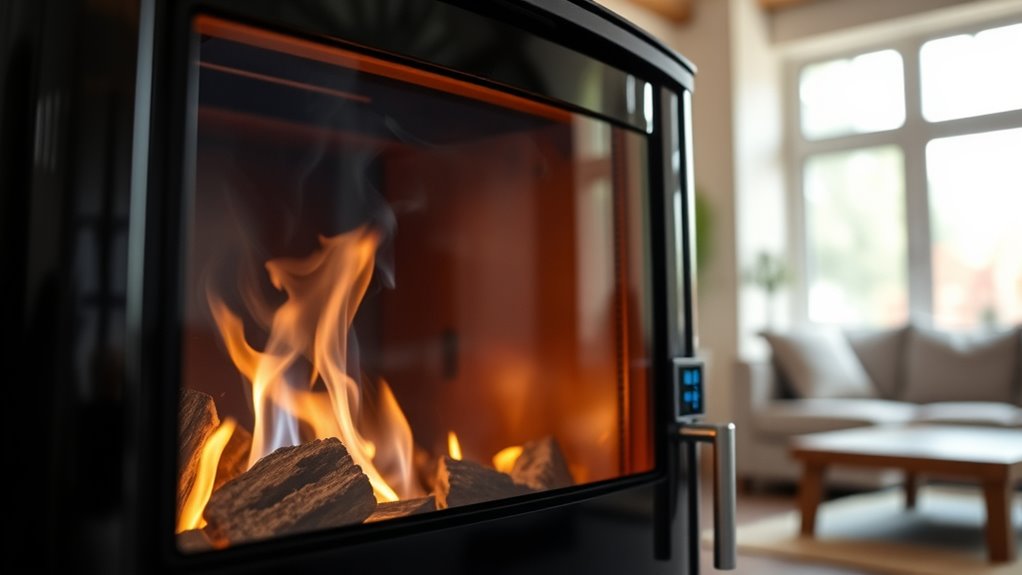
Upgrading to a modern, certified wood stove offers significant environmental and health benefits. Certified wood stoves meet strict standards like Ecodesign, ensuring emissions reduction and smokeless burning. These modern stoves boast improved combustion efficiency, which reduces unburned pollutants such as particulate matter, CO, and CH4, greatly enhancing air quality. By switching, you can cut particulate emissions by up to 80%, helping meet local standards and protecting community health. Plus, newer stoves incorporate advanced features like automated air controls and better insulation, promoting cleaner, more complete combustion. Many government incentive programs encourage upgrading to certified wood stoves, making it easier and more affordable to enjoy these benefits. Additionally, integrating innovative planter designs can inspire eco-friendly practices in other areas of sustainable living. Implementing emission reduction techniques is essential for cleaner burning, better efficiency, and a healthier environment. Proper operation and regular maintenance further contribute to air quality improvement and overall environmental health. Adopting these advanced technologies can also foster a greater awareness of holistic approaches to environmental sustainability.
Regular Maintenance and Cleaning Practices
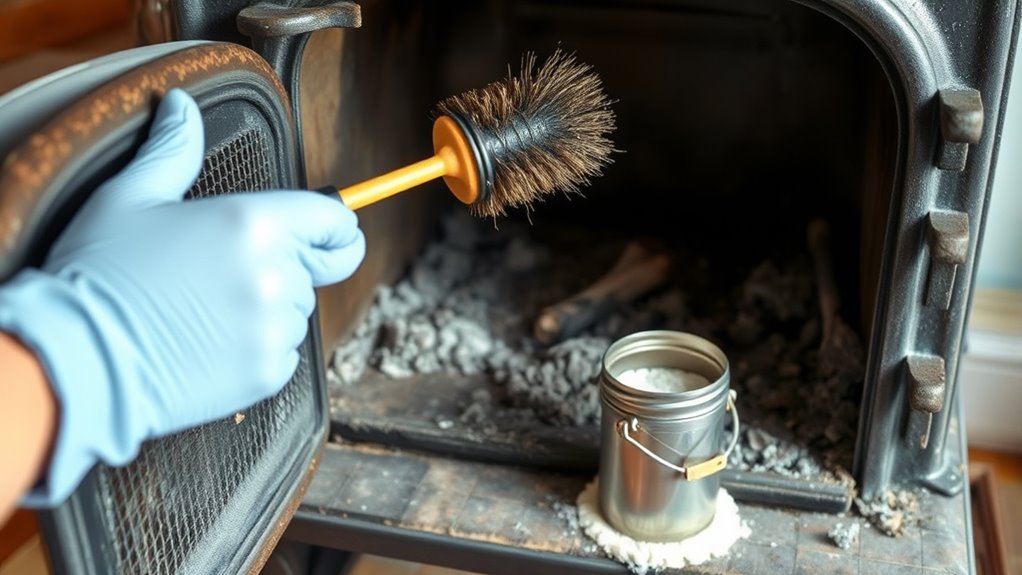
Regular maintenance and cleaning are essential for ensuring your wood stove operates efficiently and emits fewer pollutants. Regular chimney cleaning prevents creosote buildup, reducing fire hazards and improving airflow. This promotes better combustion efficiency, which minimizes soot buildup and unburned pollutants. Proper stove maintenance includes inspecting seals, firebricks, and other stove components to guarantee complete combustion. Additionally, maintaining proper airflow is critical, as it directly influences the accuracy of combustion and emission levels. Ensuring proper ventilation can further improve overall stove performance and reduce emissions. Regular appliance inspections by a professional can help identify potential issues before they lead to increased emissions or safety hazards. Monitoring filtration systems where applicable can also aid in reducing airborne pollutants resulting from incomplete combustion. Using suitable fuels can further enhance combustion efficiency and decrease harmful emissions.
Choosing Sustainable Fuel and Load Strategies
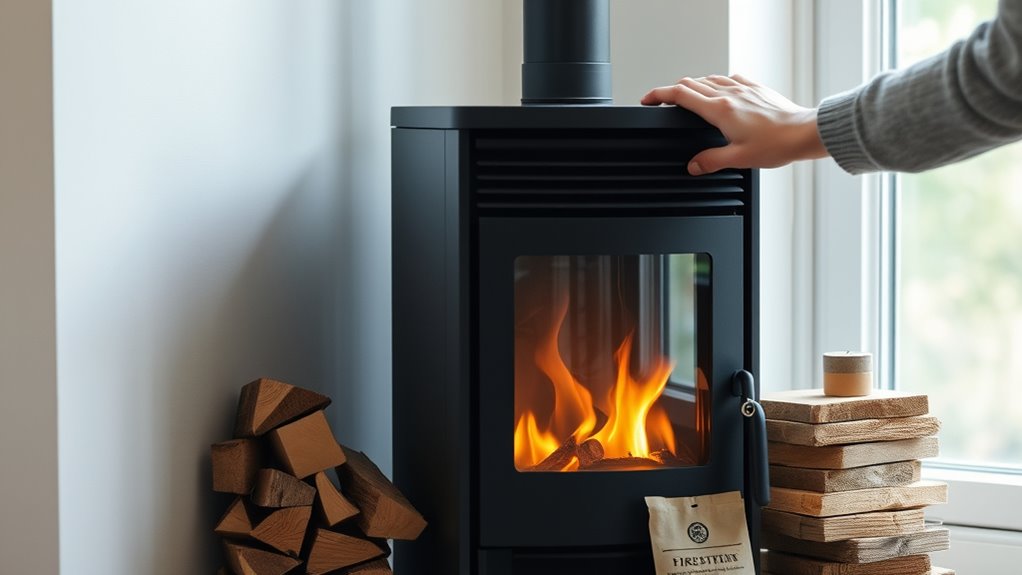
Choosing the right fuel and load strategy is crucial for efficient and clean wood stove operation. Using sustainable wood with moisture content below 20% ensures better combustion efficiency and reduces particulate matter. Load strategies matter: load small amounts of dry, well-seasoned wood frequently, rather than overloading, to maintain stable combustion and high temperature operation. Always operate at the stove’s nominal load; firing below this level can increase emissions, especially methane. Proper fuel selection and load management minimize particulate matter and emissions reduction. Position wood correctly for top lighting, avoid choking the flame, and add small pieces during operation to sustain high temperatures. Additionally, improper handling can contribute to increased smoke and pollutants, emphasizing the importance of proper operation techniques. Maintaining a consistent airflow is also essential for complete combustion and minimizing emissions, as emphasized by the subconscious power during sleep in related health practices.
Furthermore, understanding the WWE Raw’s Financial Impact underscores how strategic management and operational efficiency can lead to significant financial gains, which applies similarly to optimizing wood stove performance for environmental and economic benefits.
Frequently Asked Questions
How to Reduce Particulate Emissions From a Wood Burning Stove?
To cut particulate emissions from your wood stove, start by lighting the fire from the top and using dry, seasoned wood, which can reduce particles by up to 80%. Keep proper air regulation to achieve a blue flame, and add small amounts of wood regularly to maintain stable burning. Clean your stove and chimney often, and avoid overloading it, following the manufacturer’s guidelines to minimize emissions effectively.
What Is the Least Polluting Fuel for a Wood Burning Stove?
The least polluting fuel for your wood stove is dry, seasoned hardwood like oak or birch, which produces fewer particulates. Opt for compressed wood pellets, as they burn cleaner and more efficiently, releasing less pollution. Make sure your wood has a moisture content below 20%, avoiding green or wet wood, paper, or newspapers. Using sustainably sourced, high-quality fuel helps minimize your environmental impact and reduces emissions markedly.
Do Air Purifiers Help With Wood-Burning Stoves?
Think of air purifiers as your home’s gust of fresh air amid smoky storms. They actively catch and trap tiny particles from your wood stove emissions, reducing indoor pollution by up to 70%. While they don’t stop the smoke at the source, they’re a powerful ally in protecting your lungs, especially for vulnerable family members. Pairing an air purifier with proper stove use keeps your air cleaner and healthier.
How Do I Stop My Wood Stove From Smoking up the House?
To stop your wood stove from smoking up the house, start by using dry, seasoned wood with less than 20% moisture. Make certain you’re building small, hot fires with proper airflow—adjust the vents for a blue flame. Don’t overload the stove; instead, add small amounts of wood often. Regularly clean the chimney and stovepipe to prevent creosote buildup, which can cause poor draft and more smoke.
Conclusion
By following these simple steps, you’re not only reducing harmful emissions but also ensuring your stove operates at its best. But what if there’s an even better way to make a real difference? The future of clean, efficient heating might be closer than you think. Stay committed, stay curious—because the next shift in your heating journey could change everything. Are you ready to take that leap and access the full potential of your wood stove?

